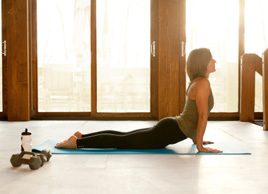
Is diet alone enough for sustained weight loss?
No. You’ll lose weight in the short term by slashing calories, but exercise is what keeps pounds off for good. Research shows that while dieting leads to short-term weight loss, the weight, like a boomerang, generally comes back. Adding exercise can change that picture.
Exercise burns calories, of course. It also builds muscle, which takes up less space than fat. The result: Your wardrobe fits better. Muscle tissue also requires more calories to sustain it than fat does. In other words, the more muscle tissue you have, the more calories you’ll burn at rest. That’s important because while diet alone may be effective at the outset, ultimately you’ll reach a plateau when your metabolism slows-and that’s when you’ll need to get moving.
A study conducted at the Washington University School of Medicine found that people who cut out 230 calories a day for a year and didn’t exercise, lost muscle mass, strength and aerobic capacity. People who exercised without cutting calories lost a similar amount of weight without sacrificing muscle mass.

Is there a best time to exercise?
Yes. If you’re simply walking to get healthy or take off some weight, it doesn’t matter when you do it as long as you do it. That could mean you’re better off exercising in the morning so the task doesn’t get bumped from your schedule by a busy day. But if you’re an athlete looking for the best-quality workout, choose the late afternoon, when body temperature is highest. Muscles are warm, reaction time is quick and strength is at its peak. If you push yourself harder as a result, you can burn more calories to boot.

Does cross-training burn more fat than a steady aerobic routine?
Yes. Doing several different activities each week burns more calories than doing only one.
If you’re someone who does only one form of exercise-say, walking or using an elliptical trainer-you may be missing out on a chance to lose more weight. A study of 72 college students conducted at the University of South Alabama found that when women who cross-trained by alternating between activities such as jumping rope, cardio-boxing, lifting weights and using a medicine ball had less body fat at the end of a 12-week training period than women who only took step aerobic classes. Both groups logged the same amount of workout time. And there was a bonus: The cross-training group felt better about their bodies and reported greater improvements in overall appearance, health and fitness compared to the people in the aerobics-only group. Cross-training not only helps you work all your body parts, it also reduces the risk of injury (you’re not stressing the same muscles and joints day after day), and it keeps things interesting.

Does interval training burn extra calories?
Yes. Adding more intense bursts of activity to your regular workout increases its effectiveness.
Here’s an idea for beefing up your exercise session without killing yourself: Throw in one block of running for every five blocks of your regular walk. The concept is called interval training-inserting short bursts of intense activity into more leisurely workouts-and it’s used by athletes to build endurance and improve performance. For regular folks, the biggest bonus may be burning more calories in the same amount of workout time. Using interval training on occasion may even help you burn more body fat on days when you do your regular workout. A small study conducted at the University of Guelph in Ontario had eight women use interval training on stationary bikes. For an hour every other day, they alternated four-minute bursts of riding at 90 percent effort with two-minute rest intervals. After the two weeks ended, the women burned 36 percent more fat when they cycled normally for an hour than they did before the interval training.
It’s likely that pushing yourself to do short bouts of harder activity recruits new muscle fibres that pitch in even during regular workouts, boosting the calorie and fat burn.
Interval training lets you challenge your muscles in ways that easier workouts don’t, without overtaxing muscles and joints and potentially hurting yourself. But if you have heart disease or high blood pressure, check with your doctor before trying any workout that makes you out of breath.

Is hitting the gym better for you than everyday exercise?
No. Most of us hit the gym with a specific goal in mind: To burn calories. But just because you take an aerobics or spinning class twice a week doesn’t mean you’ll expend more calories than if you perform basic daily tasks, or “lifestyle activities,” like scrubbing the bathtub or tending the garden.
Obesity researchers from Johns Hopkins University studied the question in obese women. Some of the women did structured aerobic exercise, while others did moderate lifestyle activities. All followed a low-fat diet with 1,200 calories a day. Both groups lost about the same amount of weight-17 lbs (7.7 kg)-over 16 weeks. What’s more, people in the “lifestyle activity” group regained less weight after a year than those in the other group.

Does exercise increase hunger?
No. It’s a common misconception: If you burn hundreds of calories during a workout, you’ll end up eating more. But research shows that exercise has no effect on food intake. In a study of 23 healthy men, researchers at the Human Appetite Research Unit at Leeds University in the United Kingdom found that hunger was suppressed during and after workout sessions and that exercisers put off eating for longer than people who didn’t exercise. But the total amount of food consumed was the same, regardless of whether people worked out at a low intensity, high intensity, or not at all.
These findings don’t apply to endurance athletes who exercise for two hours a day or more, who do compensate for the extra calories burned.

Is walking as effective as running?
Yes. Mile for mile, walking burns almost as many calories as running does, provided you walk briskly.
You’ll burn about twice as many calories while running for 30 minutes as you will walking for 30 minutes. But if a runner and a walker cover the same distance, they burn about the same number of calories, so if you’re willing to take the “slow route,” you’ll probably lose just as much weight.
In fact, studies have proved that how long you exercise matters more than how hard you exercise. This was true in a year-long study at the Cooper Institute in Dallas, which asked 201 overweight sedentary women to change their diets and follow one of four exercise programs. It found that the duration of the exercise was more important than the intensity of the exercise in terms of weight lost as well as cardiorespiratory fitness. Other studies confirm this result.
Also, of course, you’re less likely to hurt yourself when you walk instead of run. Consider this fact: When you run, your foot strikes the pavement with a force equal to 3 to 5 times your body weight. When you walk, the force is only about 1 1/2 times your body weight. The harder your foot strikes the ground, the more likely you are to be injured.
To build more muscle from walking, make sure you pick a route that includes some hills. And to encourage yourself to walk more, use a pedometer, a small gadget that counts the number of steps you take. Studies show that people who wear them walk more-and lose more weight.
One caveat: The more you walk, the more difficult it is to see results. One study at the American College of Sports Medicine found that as 27,596 women increased their weekly walking distance, the amount of weight lose as a result of walking diminished. Thus, when it comes to walking, the most overweight and sedentary people benefit the most.

Does yoga promote weight loss?
Yes. There’s no doubt that yoga burns far fewer calories than running. Even “power” versions of yoga burn only 238 calories during a 90-minute session compared to 254 calories for a 30-minute run. Nevertheless, researchers from the Fred Hutchison Cancer Center in Seattle found that among 15,500 overweight baby boomers, those who practiced yoga lost 5 lbs (2.26 kg) over 10 years, while those who never sprawled out on a yoga mat put on an average of 13.5 pounds during the same period. Researchers postulate that people who practice yoga develop greater body awareness, which may prevent them from overeating-it’s much harder to hold the downward dog position after chowing down on pizza. A one-year study of 40 male high school students in India found that yoga helped students reach their ideal body weight while also increasing their strength and endurance. Fat folds and body circumference were reduced significantly, too.
Related:
• 8 ways exercise helps beat disease
• The 8 most unusual workouts
• 8 fun ways to stay in shape
